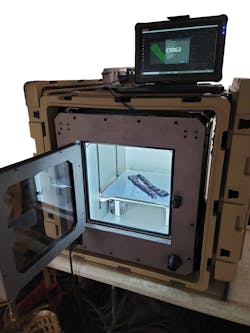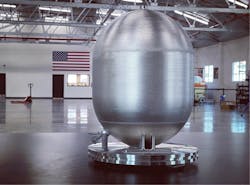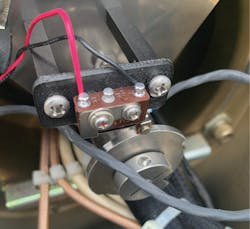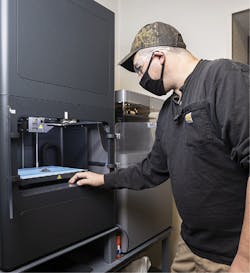By Megan Crouse
In February 2022 the White House named additive manufacturing to an updated list of critical and emergency technologies important for U.S. national security.
With 3D printing and additive manufacturing infrastructure solidifying over the last few decades, it’s clearly a priority, so how is it used in military and aerospace electronics today? Systems design and prototyping in particular stand to benefit from new developments.
Systems design
In electrical and electronic systems design, 3D printing is becoming easier and less expensive to use. As is true with traditional manufacturing, the goal always is to reduce cost and reduce the time it takes to produce a part (or, in this case, a circuit board). Manufacturing speeds and costs must improve while performance remains the same. Impossible? When it comes to printed circuit boards, Electronics Point, a technology information clearinghouse in London, notes that it can be practical.
Printing enables manufacturers to make several versions of a board quickly, speeding up the rate at which they can iterate on a design. Printing also can be a cost-effective alternative to ordering from overseas manufacturers, Electronics Point notes, as it removes much if not all of the transport time.
Another benefit of 3D printing of circuit boards, according to Electronics Point, is the ability to print conductive and non-conductive material on the same layer withdual extruders. This means a manufacturer can create either an encapsulated or product-embedded circuit board, or to print components such as resistors, capacitors, and inductors.
Essentially, a whole circuit can come out of the 3D printer; it prints an electronic system as one object. An engineer can print a device with wires already embedded inside, cutting down on assembly time. This technique still is in the experimental stage — mostly in university settings — and with curiosity from industry leaders. However, it potentially could open up new 3D printing possibilities with switches, antennas, and even induction coils embedded in the part as it is being printed.
There’s a new reason people are betting on 3D printing for semiconductors, too. 2022’s supply chain problems have made it more valuable than ever to make manufacturing in this area easier. Benny Buller, CEO and founder of Velo3D in Campbell, Calif., points out that 3D printing chips themselves whole cloth simply isn’t feasible; chips are built at the nanometer scale, and simply are too small for today’s 3D printers to produce. Instead, 3D printing can fit in where replacement parts are needed not for the chips themselves, but for the fabrication plants that build them.
In 2020, Velo3D partnered with Lam Research Corp. in Fremont, Calif., to work on printing novel materials and designs in metal for the semiconductor industry. In particular, Lam Research experts are betting on 3D printing “the highest levels of repeatability and consistency to achieve precision control at atomic scale” for semiconductor capital equipment, says Velo3D’s Buller.
3D printing for prototyping
Similarly, rapid prototyping enables engineers to print parts faster and for less cost during the prototyping stage; they can print several iterations from the same machine. 3D printing specialist Stratasys Ltd. in Eden Prairie, Minn., notes that while printed prototypes may not look aesthetically like the final product (or may require post-production in order to look that way), they can be designed to perform just as the end product will.
In applications that include a lot of feedback from the end users, including military applications, prototyping like this is becoming more common, says Eric Schnell, CEO of 3D printing startup Craitor Inc. in San Diego. His company is working with the U.S. Marine Corps and approaching other branches of the U.S. military to test 3D printed spare parts in the field.
“What 3D printing really allows for is a tactical-level view of rapid prototyping and development of Department of Defense systems,” Schnell says. “What we have seen in the rapid prototyping side is this warfighter side-development and optimization of systems they use every day. We’ve seen several cases of Marines and various other service members looking at systems they use on a day-to-day basis, reverse engineering systems but also optimizing systems.”
That might mean using the capabilities of 3D printing to reduce the number of components that go into a specific part, or building tools they normally wouldn’t have access to in the field, Schnell says. A Marine he worked with realized that a part for landing gear that usually required three people to unlatch and remove could be rebuilt so that one person could handle it alone. With the help of 3D printed prototypes, the new part was officially approved for use.
“Rapid prototyping, while traditionally looked at as something on the contractor or engineer side, is being done at the tactical level or is even being reverse sent back up the chain to the contractor saying ‘we want this capability’ or to refine this part,” Craitor’s Schnell says.
Carrying spare parts
Another major application for 3D printing today is for spare parts. GE Additive in Cincinnati in 2021 worked on a metal 3D-printed sump cover for the GE F110 engine (the engine used in the F-16). The parts were printed with cobalt-chrome powder on GE Additive’s Concept Laser M2 machine.
“Part of that process involved exploring how to quickly eliminate the associated risks with castings, and how metal additive might replace it for those parts that are either no longer in production or where we need smaller production runs to keep our platforms flying,” Melanie Jonason, chief engineer for the propulsion sustainment division at Tinker Air Force Base, Okla., told AutomationWorld.
As Craitor’s Schnell points out, one of the appealing elements of 3D printing for military applications is the ability of people with different skill levels to manufacture parts.
Digital databases and twins
For the Marine Corps, that means a digital repository of blueprints for 3D printed parts. In 2021, the Marines started working on organizing digital files and technical information that already exist but are not easily searchable or thoroughly organized.
The proposed Digital Manufacturing Data Vault will be “a one-stop-shop for approval process, version control, approved part drawings and technical data packages,” says Kristin Holzworth, chief scientist at the Quantico, Va.-based Advanced Manufacturing Operations Cell of Syscom Inc.
The Air Force also is adopting digital twinning by creating a functional virtual representation of a physical product. There have been some suggestions that the Department of Defense could mandate a contractor provide a digital twin for any approved physical product. Technically, this is a more advanced version of the kind of mirrored systems NASA used in the Apollo moon missions.
The ability to manufacture complex objects with short lead times also makes additive manufacturing very appealing to defense applications today in other ways. The U.S. Army Corps of Engineers is working on the Automated Construction of Expeditionary Structures (ACES) program, started in 2021, to print concrete structures. Smaller plastic printers also are being tested in expeditionary environments.
For Craitor’s Schnell, adapting to requirements like digital twinning is the core of his business, and he predicts requirements will mature over time. “There will be requirements that a certain number of parts or, if it is reasonable, a certain number of systems should be able to be manufactured in emergency situations by the warfighter in the field, or if not specifically in the field with assets that belong to the DoD, to improve readiness and limit the issues we see today with supply chain issues,” he says. “We’re not just seeing that in the DoD, we’re seeing that in mind in the market.”
In general, he predicts 3D printing will continue to be part of the conversation about readings and cost reduction. “What that means for the contractor, how I hear that, is that digital twin is here to stay,” Schnell says. “I doubt it will be ‘all parts must be shared, all 3D files must be kept’ and so forth. I think it will become more exclusive on certain considerations.”
Not all parts will be able to be 3D printed, no matter how good the technology gets, Schnell cautions. However, he predicts contractors will begin to have more conversations about how reasonable it is to 3D print any given part.
3D printing rocket parts
Meanwhile, Velo3D is working with Aerojet Rocketdyne in Sacramento, Calif., to bring 3D printing to space. Company engineers recently completed a project and started a second stage that focuses on printing a quad injector for a reaction control system that could fly on future NASA moon missions. The challenge was to print a part that could deliver fuel and oxidizer for the combustion chamber at the same level of functional performance as the original part. The project was a collaboration between several organizations.
As well as Velo3D and Aerojet Rocketdyne, Velo3D also collaborated with nTopology Inc., an engineering design software company in New York, that can enable complicated internal geometries.
“Every single pound of material you can remove from a spacecraft saves money on launch costs,” says James Horton, aerospace engineer and mission architect at Aerojet Rocketdyne. “That’s why we turned to nTopology for help with optimizing the design, and then Velo3D to build it for us.”
It’s a matter of manufacturing and design coming closer than before, says Zach Murphree, vice president of global sales and business development at Velo3D.
“One of the things that has been true at least throughout my career in additive manufacturing is that design and manufacturing tools have co-evolved to support each other,” says Murphree. “AM could for a while print things that were incredibly different to design and there were ways to design things that traditional manufacturing had no chance of making.”
The collaboration here was a good example of that. The initial study for the same product didn’t leverage either advanced design tools or new capabilities enabled by the partnership. And Velo3D has a lot of experience with fluid transfer, heat exchange and other specific aerospace capabilities.
“A quad injector has a built-in manifold that goes out to each of these injector faces, so that manifold tubing is complicated and requires some unique capabilities to print,” Murphree says.
He says Velo3D is seeing a shift in the way aerospace companies work with manufacturers and printing companies overall. There is a shift away from asking forspecific printing capabilities and toward general production, he says. Now, a lot of interest in AM comes from companies seeking scalability.
“Scaling into production has unique requirements traditional AM wasn’t built to address,” Murphree says. “At Velo3D, we’ve architected our system to really address some of those challenges, so the ability to print the same build file consistently and repeatedly at distributed manufacturing facilities geographically with different machine serial numbers and to do that with a high level of confidence is kind of the next step in AM becoming a truly distributed production solution.”
Process repeatability still is a big concern and limitation in AM in general, Mark Kirby, additive manufacturing business manager for Renishaw Canada Ltd. in Mississauga, Ontario, told nonprofit manufacturing association SME. That means standardizing the build environment, powder and laser management, and processing software so that you can print the same part to the same standards and with the same characteristics on different machines.
Metal printing
Metal 3D printing had been a manufacturing white whale for some time, but it’s a practical offering today.
3D printing specialist EOS in Krailling, Germany, pioneered direct metal laser sintering in 1994 with a blend of metal powders, followed by a powder bed system in 2004. The initial problem was how to melt the mix of metals, which was solved first by including one metal with a low enough melting point to form a binding matrix and later by a more powerful laser. From there, metal printing leapfrogged as the hardware and the CAD software used to build the internal geometries improved hand-in-hand.
One of the metals the aerospace industry is keeping an eye on for printing today is titanium, says Murphree. Velo3D has worked with launch vehicle and spacecraft company Launcher printing titanium pieces with very low overhangs, an engineering challenge today.
Another challenge with titanium is it tends to disappear just when you think you’ve hit the jackpot. If it’s not treated properly, the metal will “tear itself apart,” Murphree says.
“If you were to just print a titanium part and leave it on a desk it might just crack after a few days of sitting there because it has this alpha phase material that is really brittle,” he says. “But the process we use to print titanium specifically controls how the metal cools down in such a way that it prevents this cracking from happening.”
The in-situ heat treatment also works hand-in-hand with the developments in complicated geometries mentioned above: they’re enabled by the heat treatment just as the metal’s solidity is.
New types of printing also have appeared on the scene in the last few years, such as atomic diffusion additive manufacturing, demonstrated by Markforged Inc. in Billerica, Mass., and by HP Metal Jet printing from HP Development Co. L.P. in Palo Alto, Calif. Organizations continue to jockey for leadership in printing metal quickly and reliably. Velo3D also is seeing high demand for the Sapphire XC, their newest large machine. It offers a high production rate that expands the possibilities for what products companies might be able to print at competitive cost.
Velo3D also is starting to work with a copper-chromium-niobium alloy called GRCop-42 — a NASA-developed, high conductivity, high-strength dispersion strengthened alloy.
“We’ve seen a lot of requests for it,” says Murphree. “It maintains good strength at high temperature and it’s very good at conducting heat where you can’t want heat.” They’re currently in parameter testing with this copper alloy and hope to move forward with it as it opens up a new application space for Velo3D.
Printing in the field
Organizations working on military applications for printing also are redefining what types of products can be printed. For Craitor, their focus on expeditionary machines means pivoting to meet what warfighters in the field need. They print with plastic and ultra polymers, nylon carbon fiber, nylon fiberglass, carbon fiber“We focused from the beginning to make the system a tactical 3D printer, but in expeditionary environments you can’t expect an environment to be a clean, climate controlled atmosphere where you need it most,” Schnell says. “We focused from the very beginning to make it not only durable but able to print just as reliably as any other 3D printer in any environment you may find it in.”
Craitor’s project needed to be able to be carried by two people, so it has a print space of just under a foot cubed. It also needed to be able to operate under transport conditions in the field, being jostled in the back of a vehicle or subjected to natural temperature, dust, wear and tear. They’ve applied known military adaptations to their product, sealing the enclosure and using conformal coating and potting (or embedment) to protect it during transport.
“Our entire system from the ground up has inspiration from our warfighters,” Schnell says. Testing the printer on site with the people intended to use it have given them a chance to get ‘in on the ground floor’ with military adaptations for today and the future.
“Our choices of components, our UI/UX, our basic power systems [are designed to keep in mind] not only the military power supplies we see today but where they’re going,” says Schnell. “We know several services are moving toward running higher wattage power supplies within aircraft, for example. So we’re designing our system to be backwards compatible to not only where the DoD is now but where it’s going.”
Working out in the field also means the design needs to be done there. Ideally, the printer is a procurement solution as well as a tool. Contractors should look at “ease of use and automation for this capability for the warfighter” as much as anything else, he says.
“One of the advantages we’ve built into the system is a fully integrated reverse engineering and post processing suite directly into our case,” says Schnell. “That’s all the kits and tools a marine might need in the field to take measurements, do design work and build out a part but then actually do post processing of that part into a bigger assembly. That is something we knew might be useful but actually talking to our warfighter told us it was kind of a requirement and if we could fit it all into a single case it would be even better.”
In general, military customers are looking for systems that are as easy as possible to deploy. They want “ecosystems of capability” that can be operated by a minimal number people with minimal training, not necessarily by specialists. There might be one large printer at a base and several smaller ones at the ‘tip of the spear.’
Like Velo3D, Craitor also is working on expanding its roster of possible materials. Schnell says he is excited for new materials and post-processing capabilities. A company might be able to use the same material they have used for five or ten years, but develop new methods of post-processing that will make that same material double the strength.
“There is so much research going into not only entirely new polymers but new ways of printing certain polymers with the same old methodologies that create entirely new parts capabilities,” says Schnell. “If you’re really trying to gauge the lay of the land, just look at the different materials that are coming out and how they’re being combined in new and interesting ways.”





